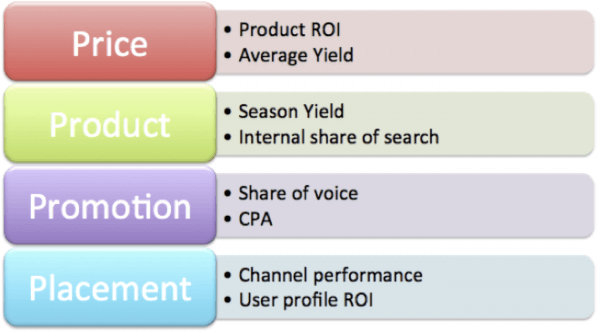Using the 4Ps of the marketing mix to give context to decision makers
Most web analytics departments in large companies are now using data to report on their online marketing performance. Navigational patterns, conversion funnels, and marketing channels have come to be the focus of most of these reports.
But what happens after these analyses are distributed? "Analytics ninjas" may comprehensively understand what is happening with their website, but do other organizational members? Who is viewing these analyses and do they have the propensity to act on the data insights?
Producing analytics reports is not a simple process, but involves numerous company resources. From technical departments for the implementation and deployment of web analytics to different levels of marketing management to adapt reports to business objectives, the whole process is undertaken whilst dealing with multiple assets and data sources.
Such big investment is always undertaken with the objective of reporting financial growth, but it is sometimes difficult to see the effect of this investment on Profit & Loss statements.
How can we use analytics to create a direct impact on marketing performance?
Fortunately, online analytics is robust and flexible enough to allow companies to employ high level metrics that are not only actionable at an executive level, but present an accurate picture of company performance. In this post, I'll show how you can use the 4Ps of the marketing mix framework to provide a familiar context to managers for reporting:

From the diagram you can see how important metrics arise as the analysts see what is happening within the website, and then these metrics become integrated into the marketing mix strategy that drives action within the company. So how does online data relate to the 4 Ps of the marketing mix. Let's now look at each element of the mix in more detail.
Price: decision making on pricing is affected by different elements such as finding the right balance between marginal profit and competitiveness. Knowledge of the following factors can greatly improve our price making decision capabilities:
- The percentage of searches where the “find the cheapest” button is clicked which result in a conversion
- Rank of products with most searches sorted by price, knowing their conversion rate
- Average yield for customer profile
Product: Product engineers aim to design products which will meet the expectations of their users. To achieve this objective they need to know:
- What are the norms of customer behavior when buying a date-related product?
- How should we target customers with complementary or ancillary products to increase cross sales? Which products are successfully sold together, where is the appropriate place/when is the appropriate stage to start cross promotion?
Promotion: finding our target audience at an appropriate cost will make the difference between a positive and a negative ROI. Therefore it is important to know:
- How do we segment our audience?
- What is the cost of reaching them?
- What kind of content shall we offer to each segment?
- And what do we expect from each of them?
Placement: Appropriate distribution of products increases customer satisfaction and reduces inefficient expenditures. Therefore to ensure optimized placement, we should ask:
- Are we using our online assets to drive sales?
- Are we optimizing performance capabilities of each online asset to drive sales?
- Are we successfully adapting the different channels to the different audience and different products available- are we correctly targeting each of our predefined segments?
Data-driven decision making
It is clear that there are many questions that need to be asked to determine the success of an online business. Online data is vital in accurately answering them.
Therefore, it is critical to align KPIs with business objectives, whether they are financial or non-financial, and customize them so that they accurately represent performance in your organisation.
These are but a few examples of key metrics that web analytics tools can produce, and which can be supplemented with economic information to enhance their capabilities as tools of performance management. When managed and observed effectively, these key metrics can encourage data based decision making, leading to actions which can optimize your financial results.
Finally, I will leave the last word to Google evangelist Avinash Kaushik:
“Without data, you are just another person with an opinion.”
Here Avinash was quoting Andreas Schleicher via Twitter in June this year to emphasize his philosophy on the importance of data in supporting business decisions. Avinash is giving his latest ideas on how to use analytics to drive results in a workshop. To hear him talk more on “Unique Challenges Facing Enterprises in Web Analytics” in London, visit www.wsab.info.
Thanks to
Anna Solans for sharing her experience in this post. With more than 15 years background in Finance and a Masters in Online Marketing, Anna Solans, along with her colleagues at Divisadero works to help clients use analytics data to drive business performance. Join them at Avinash Kaushik´s Masterclass in London to learn more.








